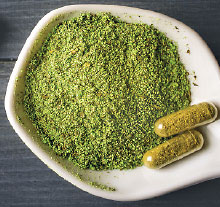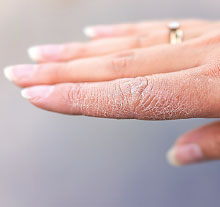Journal Digest: Storytelling & Hospitalization; Cardiac Anxiety & Latinx Individuals; Kratom & Opioid Users; OCD Symptoms on the Rise; Internet CBT & Eczema-Related Problems; Extreme Environments & Mental Health
Storytelling May Reduce Stress and Pain in Hospitalized Children

Storytelling can reduce short-term physical and psychological pain in hospitalized children, according to a study from researchers at Federal University of ABC in Sao Paolo, Brazil, and colleagues.
“[I]t is not uncommon to find storytelling programs at hospitals all over the world,” wrote the researchers in PNAS. “However, the effect of storytelling is mainly anecdotal, and its impact on children’s well-being and physiology is still insufficiently understood.”
To gain more objective data, the researchers recruited 81 children (average age: 7 years) from intensive care units to have a story read to them or play a riddle game with a trained storyteller for 25 to 30 minutes. Riddles were chosen as an active control since they also involve social interaction and paying attention but lack the narrative and emotional experience of stories. All participants provided a saliva sample and reported their pain on a standardized pain scale before and immediately after the intervention. Saliva was used to assess oxytocin (a biomarker for positive social interactions) and cortisol (a biomarker for stress).
Children in both groups had higher salivary oxytocin and lower cortisol levels following the social intervention, though oxytocin levels were nearly twice as high in the storytelling group compared with the riddle group (354 pg/ml vs. 181 pg/ml). Both groups also reported less pain following the intervention, with scores significantly lower in the storytelling group compared with the riddle group (1.15 vs. 2.18).
The findings point to “a promising venue for developing safe, innovative, and cost-effective behavioral interventions to improve psychological health and reduce the suffering of hospitalized children,” the researchers concluded.
Brockington G, Gomes Moreira AP, Buso MS, et al. Storytelling Increases Oxytocin and Positive Emotions and Decreases Cortisol and Pain in Hospitalized Children. Proc Natl Acad Sci U S A. 2021; 118(22): e2018409118.
Cardiac Anxiety Increases Risk of Adverse Outcomes in Latinx Individuals

Latinx individuals with high levels of heart-focused anxiety are at greater risk of mental health issues following exposure to trauma compared with those without such anxiety, a study in the Journal of Racial and Ethnic Health Disparities has found.
Heart-focused anxiety centers on fears and worries over cardiac-related symptoms such as chest pain and shortness of breath. Previous studies in people who do not identify as Latinx have suggested that such anxiety is associated with anxious arousal symptoms, pain, and depression.
Investigators at the University of Houston surveyed 169 Latinx college students who had been exposed to at least one traumatic event. The survey included questions related to depression, anxiety, hyperarousal, and heart-focused anxiety. Cardiovascular health was also assessed by clinicians to help quantify the anxiety.
The investigators found that heart-focused anxiety was an independent risk factor for symptoms of depression, social anxiety, hyperarousal, and suicidality among the participants. The amount that heart-focused anxiety contributed to a person’s risk for these symptoms ranged from 2% for depression to 11% for hyperarousal.
The presence of heart-focused anxiety may make people affected by trauma even more hypervigilant and avoidant of stress, thus adding to their mental health burden, the authors suggested.
“Overall, this work offers empirical evidence that individual differences in heart-focused anxiety are related to more severe co-occurring anxiety and depressive symptomatology among a particularly at-risk Latinx segment of the Latinx population (nonimmigrant Latinx young adults with previous trauma history),” the authors wrote.
Mayorga NA, Shepherd JM, Garey L, et al. Heart-Focused Anxiety Among Trauma-Exposed Latinx Young Adults: Relations to General Depression, Suicidality, Anxious Arousal, and Social Anxiety. J Racial Ethn Health Disparities. May 11, 2021. Online ahead of print
Use of Kratom Prevalent Among Users of Opioids, Cannabis

Kratom use is not uncommon in the United States, particularly among people with opioid use disorder (OUD) and cannabis use disorder. This finding comes from an analysis published in the American Journal of Preventive Medicine.
Kratom is a psychoactive plant with opioid-like properties that has gained popularity as a treatment for pain or drug withdrawal symptoms. Regulatory agencies have issued multiple warnings about kratom use owing to a risk of dependence and side effects such as agitation, depression, and seizures.
Joseph Palamar, Ph.D., M.P.H., of New York University Grossman School of Medicine examined data from the 2019 National Survey on Drug Use and Health. The 2019 survey, which was the first in which participants were asked about kratom, included responses from 56,136 individuals aged 12 and up.
Overall, 0.7% of respondents reported using kratom in the past year, with the highest rate among people ages 26 to 34. Individuals who reported prescription OUD were 3.2 times as likely to have used kratom as those with no opioid misuse, while those who misused opioids but did not have OUD were not more likely to use kratom. In contrast, people who used cannabis were about four times as likely to have used kratom, regardless of whether they had cannabis use disorder.
Palamar wrote that future research should explore whether people mainly use kratom to alleviate symptoms of cannabis use disorder or use it in conjunction with cannabis to treat other disorders.
Palamar JJ. Past-Year Kratom Use in the U.S.: Estimates From a Nationally Representative Sample. Am J Prev Med. April 29, 2021. Online ahead of print.
OCD Symptoms Rose in First Pandemic Wave

While symptoms of depression, anxiety, and obsessive-compulsive disorder (OCD) spiked during the early weeks of the COVID-19 pandemic, only obsessive-compulsive symptoms continued to rise throughout the summer of 2020, reports a study in Translational Psychiatry.
“Understanding how psychiatric symptoms change throughout the COVID-19 pandemic is essential when making inferences about the crisis’ long-term mental health consequences,” wrote the researchers from University College London.
The researchers administered psychiatric questionnaires to adults living in the United Kingdom during the first wave of the pandemic. A total of 406 adults completed these questionnaires in April/May 2020, and 296 of these adults completed follow-up questionnaires in August/September 2020. The participants also answered questions about their media habits and adherence to public health guidelines.
Symptoms related to all three disorders were heightened during the spring of 2020, but by late summer average anxiety scores plateaued and depression scores decreased modestly. Meanwhile, obsessive-compulsive symptom scores rose between April and September. The individuals who reported higher levels of obsessive-compulsive symptoms in the spring were more likely to seek out pandemic-related information and follow pandemic guidelines throughout the summer.
“The increase and persistence of [obsessive-compulsive] symptoms stress the importance of close monitoring of the public’s mental health and substantial support to alleviate the pandemic-related psychological burden,” the authors concluded.
Loosen AM, Skvortsova V, Hauser TU. High-School Football and Midlife Brain Health Problems. Transl Psychiatry. 2021; 11(1): 309.
Internet CBT Effective for Eczema-Related Psychological Problems

Internet-delivered cognitive-behavioral therapy (CBT) may help to reduce symptoms of stress, depression, and sleep problems in people with atopic dermatitis, or eczema. The findings were published in JAMA Dermatology.
People with atopic dermatitis—the most common inflammatory skin disorder—are at risk of numerous psychological symptoms, including depression and anxiety arising from self-consciousness about their appearance as well as insomnia due to intense itching.
Investigators at Sweden’s Karolinska Institute randomized 102 adults with atopic dermatitis to receive 12 weeks of internet CBT or usual care (an informational letter about atopic dermatitis and recommended treatment options). The CBT regimen included 10 modules on topics such as social stigma, mindfulness, and overcoming scratching behaviors. Trained therapists provided feedback and assistance to participants via asynchronous text messages.
After 12 weeks, the patients in the internet CBT group had significantly greater reductions in their atopic dermatitis symptoms (itching, bleeding, cracked skin) than patients in the control group. The internet CBT group also reported greater reductions in their perceived stress, sleep problems, and depression than the control group.
The study therapists spent an average of 40 minutes a patient over 12 weeks, suggesting that this form of internet CBT could be scaled up.
“Although the treatment might be simple in principle, it should be emphasized that it certainly is not easy,” the authors wrote. “[P]articipants receiving internet-delivered CBT spent approximately 35 hours working with the treatment during the 12-week treatment phase. In addition, this work revolved around approaching situations associated with fear of increased symptoms, anxiety, and stress. In other words, this treatment requires much less from the health care professional compared with face-to-face therapy, but the patient needs to work just as hard.”
Hedman-Lagerlöf E, Fust J, Axelsson E, et al. Internet-Delivered Cognitive Behavior Therapy for Atopic Dermatitis: A Randomized Clinical Trial. JAMA Dermatol. May 19, 2021. Online ahead of print
Extreme Environments Take Toll on Mental Health

Understanding how long-term isolation, confinement, and altered day/night cycles impact mental health is critical to prepare people for long-duration space flights. A study of over 100 Antarctic research personnel suggested that reducing increased feelings of detachment and indifference over time may be a key to maintain mental resilience. The study was published in Acta Astronautica.
Researchers at the University of Houston and colleagues recently developed a 23-item scale known as the Mental Health Checklist (MHCL) designed for people living in isolated, extreme environments. The scale focuses on traits such as behavioral regulation (restless and inattentive behaviors), anxious apprehension (worried and obsessive behaviors), and positive adaptation (the ability to stay positive and focused).
The researchers invited 88 personnel stationed at the South Pole and 22 at a coastal Antarctic station to complete the MHCL monthly to assess long-term as well as month-to-month psychological changes. Each month, participants completed the MHCL along with other surveys on mental and physical health. The personnel at the South Pole station completed nine monthly assessments while the coastal personnel completed one to seven monthly assessments.
The researchers found that both positive adaptation and self-regulation decreased in the first few months of deployment. However, while self-regulation improved over time, positive adaptation scores continued to decrease. “Thus, even as crew members were preparing to return home, positive adaptation scores did not evidence a ‘bounce back’ effect,” the authors wrote.
Anxious apprehension levels varied from month-to-month but did not show any long-term trends.
Although baseline psychological traits could not predict which personnel would experience significant changes in mental health after nine months, the researchers found that personnel who more frequently savored and expressed positive emotions were more likely to have higher positive adaptation scores when they left. ■
Alfano CA, Bower JL, Connaboy C, et al. Mental Health, Physical Symptoms, and Biomarkers of Stress During Prolonged Exposure to Antarctica’s Extreme Environment. Acta Astronautica. 2021; 181: 405-413.



